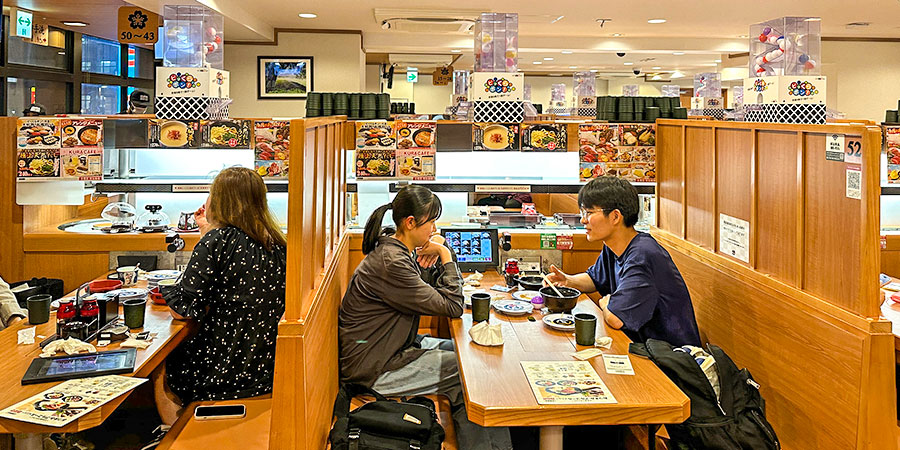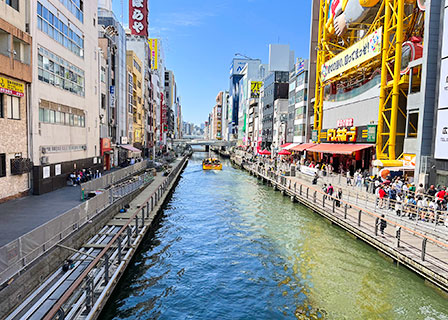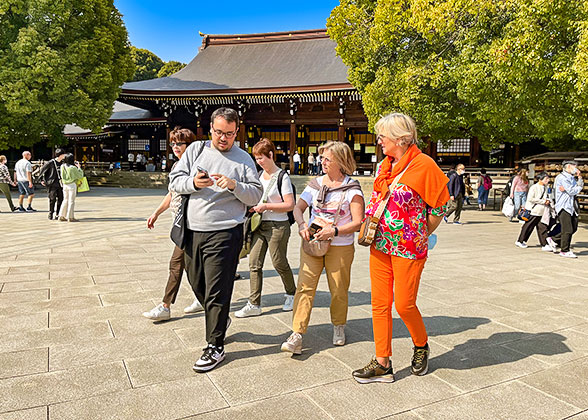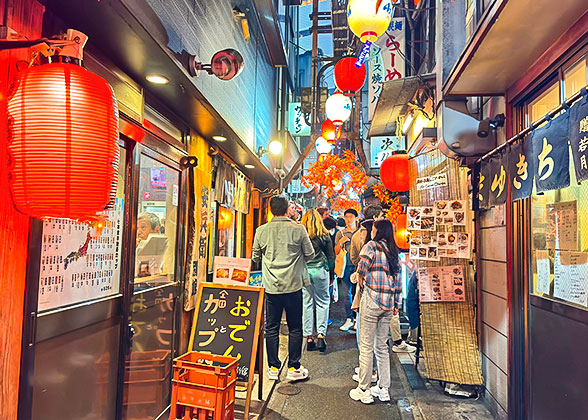Japanese Table Manners
Japanese food is pretty tempting for visitors from the world, but meanwhile Japanese pursue a sophisticated culture of table etiquettes. There are the points of Japanese table manners requiring attention.Sitting, Seating and More before Dining
In Japan, it is go-as-you-please in the western restaurants. However, you should be aware when dining in a traditional Japanese restaurants, especially those with tatami paved on the floor and futon – Japanese cushions set instead of chairs or stools. At the door of such a restaurant or box, you need to take off your shoes, and then squat down to put the shoes at the specific place next to the door, with the toes inwards neatly.

Dining at a Restaurant in Japan
|
As for sitting on the cushion, Japanese sit on heels. Do as the Japanese do, you could learn to sit on your heels, too, with your two soles of foot in a V-shape.
If you go out for a dinner with your cooperative partners or others in Japan, the host, leaders, and the elders usually sit at the position farthest from the door. For a private get-together with peers, the inviter will sit near the door, so as to pay the bill more expediently.
Table Manners When Dining in Japan
As the dishes are served on the table, you should say “Itadakimasu” (I’m to eat) before the first bite. Just like saying grace, this is a respect to the food as well as the host. After the meal, you could say “go-chiso-samadeshita” (Thank you for your hospitality!).|
|
|
Lift Up Your Bowl When Eating
For a traditional Japanese meal, Japanese usually take a pair of chopsticks in the right hand, while take up the bowl or small plate with the left hand. They will pick the bowl or small plate up to the chest level while having a meal, and bring the food to their mouth. Because they have considered that it’s not nice-looking to eat over a plate on the table. You could take the bowls, saucer, etc. up, but don’t touch the larger ware with your hand. These food in the large containers, such as sashimi, tempera and fish, are picked up through chopsticks to the mouth. Even having a box of bento, you’d better pick the food up with chopsticks.Then again, Japanese would take their bowls up when having a traditional meal, as the tableware for everyone won’t be big. However, they would also let the bowl with food on the table, and lower their head to eat, like having ramen or okonomiyaki. Such a food is usually not the traditional meal but Japanese fast food.
Order to Taste Dishes
According to Japanese habits, they will try the soup at first, followed by the major food, and the staple food rice at last. If there are quite a few dishes, you can take a bite of each dish successively as they are served. Although traditional Japanese dishes are served in several small plates, it does not mean that eat the same dish up at once.To have a soup, they will sip the stock – the liquor at first. If the soup bowl has a lid, hold the bowl with your left hand, and take off the lid with your right hand. Put the lid on the right side of your rice bowl with the inside side up. Press the food in the soup with chopsticks, smell the aroma of this soup, and drink the stock. After that, you can eat the food left in the soup with your chopsticks. As the soup is eaten up, cover the lid and put the soup bowl back.
Japanese Table Manners about Using Chopsticks

Chopsticks in Japan Restaurant
|
![]() For the disposable chopsticks that the round ends stick together, you need to gently pull apart only. When taking the chopsticks in a formal or traditional case, pinch in the middle with your right hand, and hold up the round end with your left hand. Move your right hand to the round end, and release your left hand after you hold the chopsticks firmly.
For the disposable chopsticks that the round ends stick together, you need to gently pull apart only. When taking the chopsticks in a formal or traditional case, pinch in the middle with your right hand, and hold up the round end with your left hand. Move your right hand to the round end, and release your left hand after you hold the chopsticks firmly.
![]() When you are talking or other occasions in which you aren’t eating, put your chopsticks neatly on the chopstick stand, with the pointed end on the stand.
When you are talking or other occasions in which you aren’t eating, put your chopsticks neatly on the chopstick stand, with the pointed end on the stand.
![]() Don't knock your bowl with chopsticks during meals.
Don't knock your bowl with chopsticks during meals.
![]() Neither insert your chopsticks into the rice, nor poke or stir the food in your plate. Don’t rummage the food with your chopsticks.
Neither insert your chopsticks into the rice, nor poke or stir the food in your plate. Don’t rummage the food with your chopsticks.
![]() Never point your chopsticks at others, which means you want the person to leave.
Never point your chopsticks at others, which means you want the person to leave.
![]() To divide a big food like an entire chicken or fish into pieces, utilize the round end of a clean pair of chopsticks if there is no special tools.
To divide a big food like an entire chicken or fish into pieces, utilize the round end of a clean pair of chopsticks if there is no special tools.
Behaviors at the Table
![]() It is considered a good virtue to eat all the food on your plate. If you don't like or you can't eat a food, please tell the restaurant or hotel directly. Thus, they could offer an alternative or you can choose another dish.
It is considered a good virtue to eat all the food on your plate. If you don't like or you can't eat a food, please tell the restaurant or hotel directly. Thus, they could offer an alternative or you can choose another dish.
![]() Don't talk about something about the bathroom during the meal.
Don't talk about something about the bathroom during the meal.
![]() Don't speak with food in your mouth.
Don't speak with food in your mouth.
![]() Don’t spit out the food have put into your mouth.
Don’t spit out the food have put into your mouth.
![]() After eating in a Japanese fast food restaurant, you may be requested to collect your dinner set by yourself. In nicer restaurants, the waiter or waitress will tidy up the table after your dinner.
After eating in a Japanese fast food restaurant, you may be requested to collect your dinner set by yourself. In nicer restaurants, the waiter or waitress will tidy up the table after your dinner.
![]() If you are going to pick your teeth, please cover your mouth with your hand.
If you are going to pick your teeth, please cover your mouth with your hand.

|
Table Etiquettes about Drinking
![]() It is rude to be drunk in restaurants in Japan, especially the formal ones. In the izakaya or bistro, it’s OK as long as you aren’t roaring drunk or don’t disturb other dinners there.
It is rude to be drunk in restaurants in Japan, especially the formal ones. In the izakaya or bistro, it’s OK as long as you aren’t roaring drunk or don’t disturb other dinners there.
![]() When having a meal and drinking with friends, Japanese would serve each other to pour the sake. They won’t pour the alcohol for themselves as long as they are not alone. Thus, they will pay attention to others’ cups so as to refill in time.
When having a meal and drinking with friends, Japanese would serve each other to pour the sake. They won’t pour the alcohol for themselves as long as they are not alone. Thus, they will pay attention to others’ cups so as to refill in time.
![]() If someone on the same table is to pour sake for you, you should sip a little from your cup after straight away, and the rest of sake in the cup should be sipped for a few times.
If someone on the same table is to pour sake for you, you should sip a little from your cup after straight away, and the rest of sake in the cup should be sipped for a few times.
![]() A toast is usually made after everyone has sipped once at least.
A toast is usually made after everyone has sipped once at least.
Table Manners to Enjoy Sushi
As sushi is a unique Japanese food, it’s essential to learn that how to enjoy it properly according to Japanese table manners.

Fresh Sushi Served
|
![]() Pick the sushi with chopsticks or take it with your hand directly. There is a type of sushi called nigari-sushi, which you can hold it with your hand directly.
Pick the sushi with chopsticks or take it with your hand directly. There is a type of sushi called nigari-sushi, which you can hold it with your hand directly.
![]() Eat a piece of sushi in one bite. Don't try to split a piece of sushi in half, which is a destruction of food in Japan.
Eat a piece of sushi in one bite. Don't try to split a piece of sushi in half, which is a destruction of food in Japan.
![]() Dip the side of raw fish slice or other meat in the soy sauce, while trying not to let the rice stained with soy sauce.
Dip the side of raw fish slice or other meat in the soy sauce, while trying not to let the rice stained with soy sauce.
![]() For gunkan sushi - those rolled inside nori, you can pick it on your own plate and pour little soy sauce onto it. Don’t immerse it into the soy sauce.
For gunkan sushi - those rolled inside nori, you can pick it on your own plate and pour little soy sauce onto it. Don’t immerse it into the soy sauce.
More Tips
![]() No smoking in restaurants. Some restaurants may provide the smoking tables or area for smokers, ask the waiter whether there is or not if you want to smoke.
No smoking in restaurants. Some restaurants may provide the smoking tables or area for smokers, ask the waiter whether there is or not if you want to smoke.
![]() When eating in a restaurant or invited to dinner as a guest in a Japanese family, it is customary to wipe your hands with a small wet towel (oshibori) offered. However, never wipe your face and neck with this towel, which is thought to be impolite.
When eating in a restaurant or invited to dinner as a guest in a Japanese family, it is customary to wipe your hands with a small wet towel (oshibori) offered. However, never wipe your face and neck with this towel, which is thought to be impolite.
![]() When enjoying noodles in Japan, you may try to slurp as people around you do. It won’t be impolite, but regarded as a praise to the delectable noodles on the contrary. Japanese slurp to show that the noodles are very delicious with all their heart and they enjoy it very much.
When enjoying noodles in Japan, you may try to slurp as people around you do. It won’t be impolite, but regarded as a praise to the delectable noodles on the contrary. Japanese slurp to show that the noodles are very delicious with all their heart and they enjoy it very much.
![]() If you don’t drink sake or other alcohol, non-alcoholic beverages are often available. If you travel with kids, you can also order the kid(s) soft drinks, such as juice, tea and sodas.
If you don’t drink sake or other alcohol, non-alcoholic beverages are often available. If you travel with kids, you can also order the kid(s) soft drinks, such as juice, tea and sodas.
Read More:




